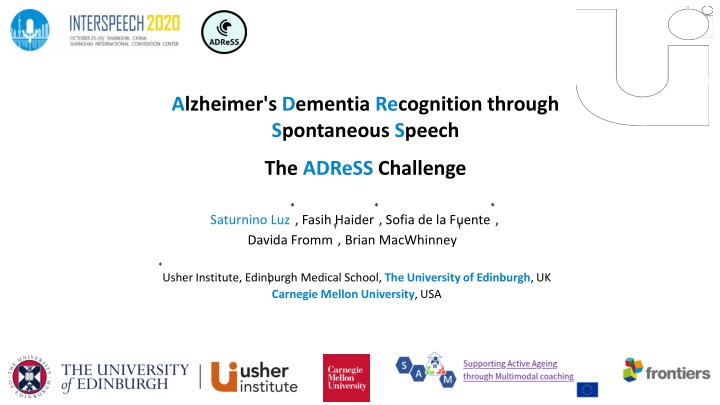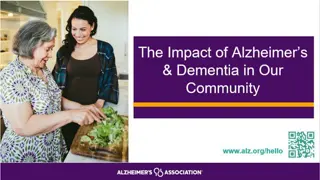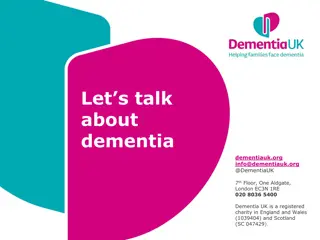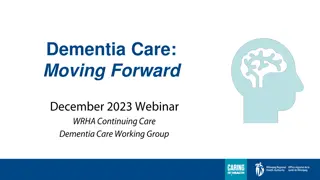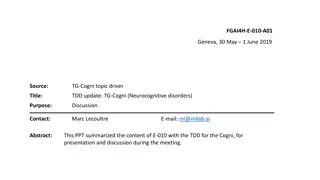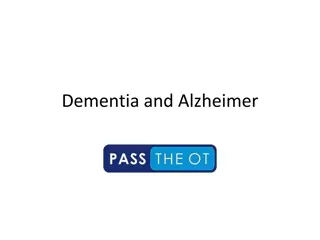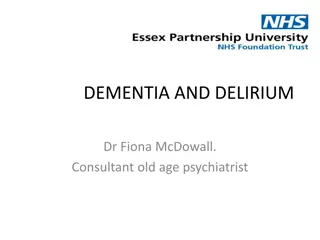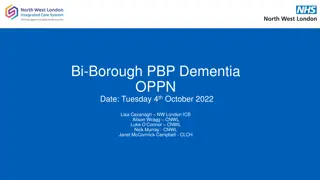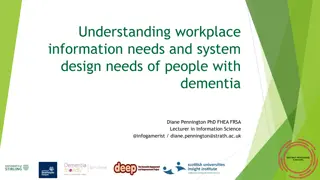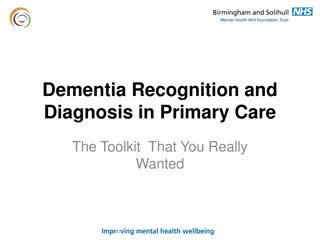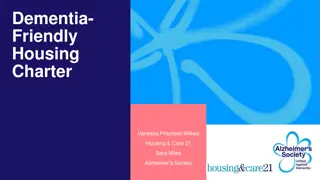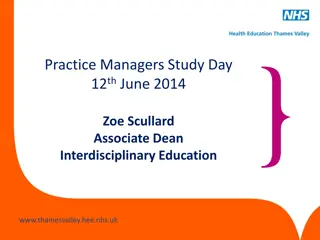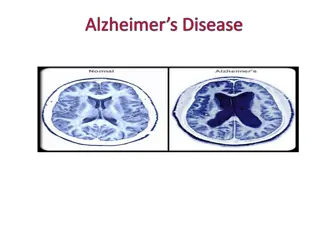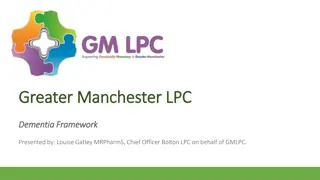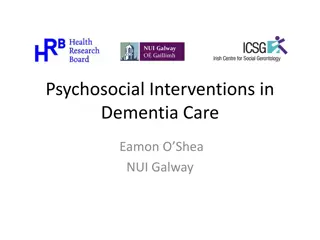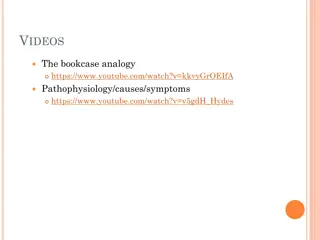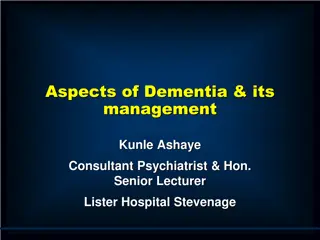Alzheimer's Dementia Recognition Challenges & Solutions
Alzheimer's is a neurodegenerative disease affecting cognitive function. The ADReSS Challenge explores using spontaneous speech for detection, focusing on Alzheimer's Dementia classification and MMSE score regression tasks. The dataset is balanced by age and gender, with baseline results indicating promise in acoustic and linguistic modalities.
Download Presentation

Please find below an Image/Link to download the presentation.
The content on the website is provided AS IS for your information and personal use only. It may not be sold, licensed, or shared on other websites without obtaining consent from the author.If you encounter any issues during the download, it is possible that the publisher has removed the file from their server.
You are allowed to download the files provided on this website for personal or commercial use, subject to the condition that they are used lawfully. All files are the property of their respective owners.
The content on the website is provided AS IS for your information and personal use only. It may not be sold, licensed, or shared on other websites without obtaining consent from the author.
E N D
Presentation Transcript
Alzheimer's Dementia Recognition through Spontaneous Speech Better health, better futures Better health, better futures The ADReSS Challenge * * * Saturnino Luz Davida Fromm , Fasih Haider , Sofia de la Fuente , Brian MacWhinney , * Usher Institute, Edinburgh Medical School, The University of Edinburgh, UK Carnegie Mellon University, USA
Background Alzheimer s is a neurodegenerative disease that entails a long-term and usually gradual decrease of cognitive functioning. Clinical manifestations include: Subjective Memory Loss (SML) Mild Cognitive Impairment (MCI) and Alzheimer's Dementia (AD) There is a need for low-cost, scalable approaches to detection of AD and MCI Speech may provide an easily obtainable and reliable source of data for such approaches * S. Luz, F. Haider, S. de la Fuente, D. Fromm, and B. MacWhinney. Alzheimer's dementia recognition through spontaneous speech: The ADReSS challenge. In Proceedings of INTERSPEECH 2020, Shanghai, China, 2020. (Pre-print available at https://arxiv.org/abs/2004.06833) Signal processing and machine learning methods could help with automation and scalability https://arxiv.org/abs/2004.06833
Gathering speech data Standardised cognitive tests exist which use speech in controlled settings. Use of spontaneous speech data presents some advantages: Can be captured in natural settings, over time May overcome daily fluctuations that affect cognitive test performance: fatigue, mood, attentiveness, short-term illnesses, test anxiety, etc Some research groups have investigated AD detection based on spontaneous speech However, the field lacked balanced and standardised data sets on which different approaches can be compared. * S. Luz, F. Haider, S. de la Fuente, D. Fromm, and B. MacWhinney. Alzheimer's dementia recognition through spontaneous speech: The ADReSS challenge. In Proceedings of INTERSPEECH 2020, Shanghai, China, 2020. (Pre-print available at https://arxiv.org/abs/2004.06833) https://arxiv.org/abs/2004.06833
ADReSS Two automatic prediction tasks: Alzheimer s Dementia classification task Cognitive test (MMSE) score regression task The ADReSS Challenge dataset is acoustically pre-processed balanced in terms of age and gender Available through DementiaBank: https://dementia.talkbank.org/ Baseline results* provided for acoustic and linguistic modalities separately: Classification: 62% (acoustic features) and 75% (linguistic features) Regression: 6.14 rmse (acoustic features) and 5.20 (linguistic features) * S. Luz, F. Haider, S. de la Fuente, D. Fromm, and B. MacWhinney. Alzheimer's dementia recognition through spontaneous speech: The ADReSS challenge. In Proceedings of INTERSPEECH 2020, Shanghai, China, 2020. (Pre-print available at https://arxiv.org/abs/2004.06833) https://arxiv.org/abs/2004.06833
The speech collection task Cookie Theft picture description task the Boston Diagnostic Aphasia Exam Part of DementiaBank s Pitt Corpus Transcripts annotated using the CHAT coding system Recordings were acoustically enhanced with stationary noise removal Audio volume was normalised across all speech segments control for variation caused by recording conditions, such as microphone placement. * S. Luz, F. Haider, S. de la Fuente, D. Fromm, and B. MacWhinney. Alzheimer's dementia recognition through spontaneous speech: The ADReSS challenge. In Proceedings of INTERSPEECH 2020, Shanghai, China, 2020. (Pre-print available at https://arxiv.org/abs/2004.06833) https://arxiv.org/abs/2004.06833
The Dataset Carefully selected so as to mitigate common biases: repeated occurrences of speech from the same participant variations in audio quality, and imbalances of gender and age distribution. Segmented for voice activity based on a signal energy threshold. 65dB, maximum of 10 seconds per segment. 1,955 speech segments from 78 non-AD participants and 2,122 speech segments from 78 AD participant. The average number of speech segments per participant 24.86 (sd=12.84) * S. Luz, F. Haider, S. de la Fuente, D. Fromm, and B. MacWhinney. Alzheimer's dementia recognition through spontaneous speech: The ADReSS challenge. In Proceedings of INTERSPEECH 2020, Shanghai, China, 2020. (Pre-print available at https://arxiv.org/abs/2004.06833) https://arxiv.org/abs/2004.06833
Training-test split AD non-AD F 0 4 6 10 8 2 30 Age [50, 55) [55, 60) [60, 65) [65, 70) [70, 75) [75, 80) Total M 1 5 3 6 6 3 24 F 0 4 6 MMSE (sd) 30.0 (n/a) 16.3 (4.9) 18.3 (6.1) 16.9 (5.8) 15.8 (4.5) 17.2 (5.4) 17.0 (5.5) M 1 5 3 6 6 3 24 MMSE (sd) 29.0 (n/a) 29.0 (1.3) 29.3 (1.3) 29.1 (0.9) 29.1 (0.8) 28.8 (0.4) 29.1 (1.0) Training set 10 8 2 30 AD non-AD F 0 2 3 4 3 1 1 3 MMSE (sd) 23.0 (n.a) 18.7 (1.0) 14.7 (3.7) 23.2 (4.0) 17.3 (6.9) 21.5 (6.3) 19.5 (5.3) MMSE (sd) 28.0 (n.a) 28.5 (1.2) 28.7 (0.9) 29.4 (0.7) 28.0 (2.4) 30.0 (0.0) 28.8 (1.5) Age [50, 55) [55, 60) [60, 65) [65, 70) [70, 75) [75, 80) Total M 1 2 1 3 3 1 1 1 F 0 2 3 4 3 1 M 1 2 1 3 3 1 1 1 Test set 1 3 * S. Luz, F. Haider, S. de la Fuente, D. Fromm, and B. MacWhinney. Alzheimer's dementia recognition through spontaneous speech: The ADReSS challenge. In Proceedings of INTERSPEECH 2020, Shanghai, China, 2020. (Pre-print available at https://arxiv.org/abs/2004.06833) https://arxiv.org/abs/2004.06833
Baseline: feature generation Acoustic features: emobase: MFCC, voice quality, fundamental frequency (F0), F0 envelope, LSP and intensity features with their first and second order derivatives, and functionals. (988 features) Compare: energy, spectral, MFCC, and voicing related low-level descriptors, including harmonic-to-noise ratio, voice quality, Viterbi smoothing for F0, spectral harmonicity and psychoacoustic spectral sharpness, andfunctionals.(6,373 features) eGeMAPS: basic set of theoretically motivated acoustic features. (88 features). MRCG: gammatone filter decomposition of audio in the * S. Luz, F. Haider, S. de la Fuente, D. Fromm, and B. MacWhinney. Alzheimer's dementia recognition through spontaneous speech: The ADReSS challenge. In Proceedings of INTERSPEECH 2020, Shanghai, China, 2020. (Pre-print available at https://arxiv.org/abs/2004.06833) frequency domain so as to mimic the human auditory filters. https://arxiv.org/abs/2004.06833
The baseline system A(i), the recording segmented using voice activity detection into n segments x(i, n) Feature extraction is performed at segment level for acoustic features And at recording level for linguistic features For acoustic features: The output for the n segment of the i MV: majority voting for classification; Average for regression. th th recording is: y(i, n). * S. Luz, F. Haider, S. de la Fuente, D. Fromm, and B. MacWhinney. Alzheimer's dementia recognition through spontaneous speech: The ADReSS challenge. In Proceedings of INTERSPEECH 2020, Shanghai, China, 2020. (Pre-print available at https://arxiv.org/abs/2004.06833) https://arxiv.org/abs/2004.06833
Baseline results for AD/non-AD classification LOSO cross validation accuracy. LOSO test set accuracy. Features emobase ComParE eGeMAP S MRC G Minimal linguistic LDA 0.500 0.519 0.398 0.491 0.472 0.476 0.565 0.528 0.574 0.528 0.509 0.541 0.482 0.500 0.380 0.333 0.482 0.435 0.519 0.500 0.482 0.528 0.509 0.507 0.519 0.667 0.426 0.565 0.583 0.552 0.768 0.704 0.740 0.602 0.750 0.713 DT 1NN SVM RF mean Features emobase ComParE eGeMAP S MRCG Minimal linguistic LDA 0.542 0.688 0.604 0.500 0.729 0.613 0.625 0.625 0.458 0.500 0.542 0.550 0.583 0.542 0.688 0.563 0.604 0.596 0.542 0.563 0.417 0.521 0.542 0.517 0.604 0.562 0.604 0.667 0.583 0.604 0.750 0.625 0.667 0.792 0.750 0.717 DT 1NN SVM RF mean mean 0.559 0.570 0.500 0.508 0.551 mean 0.608 0.601 0.573 0.590 0.625 Baseline results summary (LDA)clas s SOA cous STA cous SOl i n g AD non-AD AD Precision 0.56 0.57 Recall 0.61 0.52 F1 Score 0.58 0.54 Accuracy non-AD AD 0.56 non-AD AD 0.67 0.60 0.50 0.75 0.57 0.67 0.62 non-AD 0.76 0.77 0.70 0.83 0.78 0.76 0.87 0.62 0.77 0.77 0.78 0.71 0.77 0.75 STl i n g * S. Luz, F. Haider, S. de la Fuente, D. Fromm, and B. MacWhinney. Alzheimer's dementia recognition through spontaneous speech: The ADReSS challenge. In Proceedings of INTERSPEECH 2020, Shanghai, China, 2020. (Pre-print available at https://arxiv.org/abs/2004.06833) https://arxiv.org/abs/2004.06833
Baseline results for MMSE score regression LOSO cross validation (chance RMSE = 7.18) Features Linear DT GP SVM LSBoost mean emobase ComParE eGeMAPS MRCG Minimal Linguistic mean 7.44 15.69 8.08 13.46 7.39 6.15 9.70 7.29 7.29 7.31 7.28,r = 0.76 7.60 4.38,r = 0.79 6.86 7.71 7.67 7.72 7.65 7.18 7.92 7.64 7.71 7.63 8.55 7.50 8.01 6.34 7.62 8.33 7.84 8.68 8.02 7.14 7.44 7.91 7.70 9.22 8.07 8.78 7.46 6.45 MMSE prediction test results. Linear DT 6.80 6.78 6.47 6.52 6.90 5.99 6.70 6.14,r = 0.22 6.29 6.84 4.78 5.20,r = 0.57 6.32 6.25 Features emobase ComParE eGeMAPS MRCG Minimal Linguistic mean GP 6.36 6.33 6.28 6.33 6.58 5.54 6.24 SVM 6.18 6.19 6.12 6.20 6.19 6.24 6.19 LSBoost 6.73 6.72 6.41 6.31 7.71 6.62 6.75 mean 6.57 6.45 6.34 6.33 6.72 5.68 * S. Luz, F. Haider, S. de la Fuente, D. Fromm, and B. MacWhinney. Alzheimer's dementia recognition through spontaneous speech: The ADReSS challenge. In Proceedings of INTERSPEECH 2020, Shanghai, China, 2020. (Pre-print available at https://arxiv.org/abs/2004.06833) https://arxiv.org/abs/2004.06833
Challenge results: classification task (top 14) Participant Accuracy F1-Score (nonAD) F1-Score (AD) F1-Score (mean) University of Michigan 0.8958 0.8889 0.902 0.8955 Baidu USA 0.8958 0.902 0.8889 0.8955 UPF Barcelona 0.875 0.8846 0.8636 0.8741 Auto-ID Lab, Massachusetts Institute of Technology 0.875 0.875 0.875 0.875 IDIAP 0.8542 0.8444 0.8627 0.8536 The University of Arizona 0.8542 0.8571 0.8511 0.8541 RMIT University, Australia/Mehran University of Engineering & Technology, Pakistan 0.8542 0.8627 0.8444 0.8536 University of Alberta 0.8542 0.8679 0.8372 0.8526 Winterlight Labs, Toronto 0.8333 0.8261 0.84 0.8331 SSN College of Engineering Kalavakkam 0.8333 0.8462 0.8182 0.8322 DFKI 0.8333 0.8333 0.8333 0.8333 MIT Media Lab, Massachusetts Institute of Technology 0.8333 0.8333 0.8333 0.8333 INESC-ID's Human Language Technology Lab, Pt 0.8125 0.8364 0.7805 0.8085 Music and Audio Research Group at Seoul National University 0.8125 0.8085 0.8163 0.8124 * S. Luz, F. Haider, S. de la Fuente, D. Fromm, and B. MacWhinney. Alzheimer's dementia recognition through spontaneous speech: The ADReSS challenge. In Proceedings of INTERSPEECH 2020, Shanghai, China, 2020. (Pre-print available at https://arxiv.org/abs/2004.06833) https://arxiv.org/abs/2004.06833
MMSE score regression results (top 14) Participant RMSE Music and Audio Research Group at Seoul National University 3.7472 University of Michigan 4.2902 RMIT University, Australia/Mehran University of Engineering & Technology, Pakistan 4.3012 SSN College of Engineering Kalavakkam 4.3268 University of Illinois Chicago 4.3396 JSI 4.4388 QMUL 4.5372 UPF Barcelona 4.5414 Winterlight Labs, Toronto 4.5635 Kings College London 4.5827 MIT Media Lab, Massachusetts Institute of Technology 4.6017 IDIAP 4.648 University of Sheifield 4.6594 Universit t Augsburg 4.686 * S. Luz, F. Haider, S. de la Fuente, D. Fromm, and B. MacWhinney. Alzheimer's dementia recognition through spontaneous speech: The ADReSS challenge. In Proceedings of INTERSPEECH 2020, Shanghai, China, 2020. (Pre-print available at https://arxiv.org/abs/2004.06833) https://arxiv.org/abs/2004.06833
